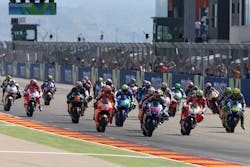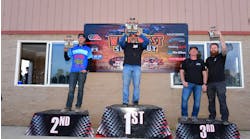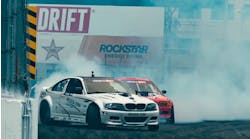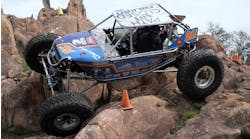Round fourteen of the 2015 MotoGP season was the Aragon Grand Prix in which Movistar Yamaha MotoGP’s Jorge Lorenzo won in convincing fashion ahead of Dani Pedrosa and Valentino Rossi who finished in second and third place respectively.
The race weekend experienced stable weather with dry conditions throughout all of the sessions and track temperatures reaching a peak of around 35° each afternoon, including Sunday’s race. The pace shown at Aragon was much quicker than in previous years with all lap records falling. In qualifying, Marc Marquez set a new Aragon Circuit Best Lap record of 1’46.635 and in the race Jorge Lorenzo set a new Circuit Record Lap time of 1’48.120 and completed the race in a time of 41'44.933, beating the previous overall race time record by over eighteen seconds.
Q&A with Masao Azuma – Chief Engineer, Bridgestone Motorcycle tire Development Department
The 2015 specification hard compound front slick has been quite popular this year and was in the Aragon allocation, yet no riders tried it over the weekend. Was this a surprise for you?
“We included the hard compound front slick in our Aragon tire allocation, but it was the ‘option’ front slick specification for this race. At each race, we offer three front slick compounds, two of which are the primary specifications, which are available in greater number and the option specification of which the riders can select a maximum of three pieces. Front-end stability is important at Aragon which would suggest using the hard compound front slick, but good edge grip and warm-up performance are also crucial and this is why the medium compound front slick was popular as it meets these requirements as well. Some riders considered evaluating the hard compound front slick in FP4 but with the weather forecast showing similar track temperatures on Sunday, they decided it wouldn’t be needed.”
The medium compound rear slick you brought to Aragon this year was widely used over the race weekend. What was it about this tire that made it so popular with the riders?
“Compared to the medium rear slick specification we brought to Aragon last year, this year’s medium rear was optimized to give better edge grip without compromising durability. This was an important development as it gives the riders better cornering performance, particularly through the long radius left-hand corners like turns 10, 16 and 17. The hard compound rear slick was also a good option for the factory Honda and Yamaha riders, however with track temperatures staying below forty degrees over the weekend, the medium rear slick was better suited to the conditions. The soft compound rear slick also showed it could perform over race distance for the open class riders, so I think we got the balance right with the compound options we offered at this year’s Aragon Grand Prix.”
Track temperatures in the morning sessions got as low as 17 degrees Celsius. On a circuit like Aragon, how does this effect tire performance?
“Generally, when you have cold track temperatures having tires with good warm-up performance is important, but at Aragon it is even more crucial. This is because even though the circuit isn’t too unbalanced in terms of the number of left and right hand turns, the distance from the right-handed turn 14 to the next right-hand corner, turn two, is over one-and-a-half kilometers. This means that the right shoulder of the tire needs to effectively retain heat; an important consideration when devising our tire allocation for Aragon. The cold temperatures also sometimes cause graining on the rear tires, especially when the track is dirty like it was for FP1. However, this year we didn’t see much graining on the rear tires which means they were reaching optimum operating temperature quickly.”
Latest in Racing
Latest in Racing
Racing
Nexen Tire Announces 2024 Motorsports Program
April 19, 2024
Racing
GT Radial Secures Formula Drift Podium Finishes
April 15, 2024




